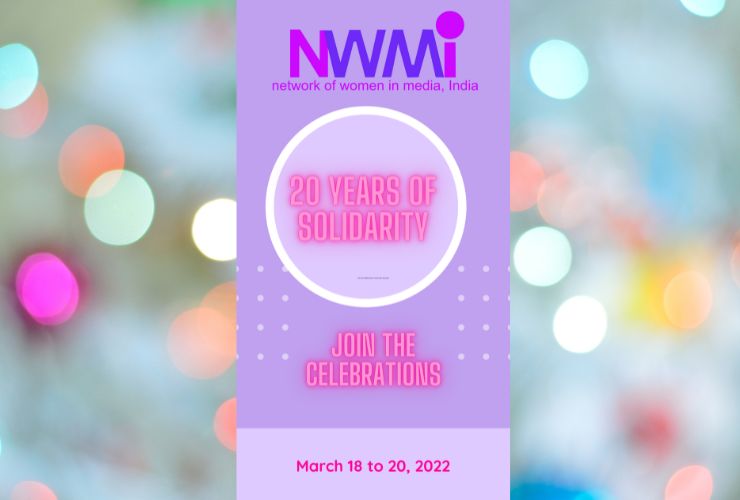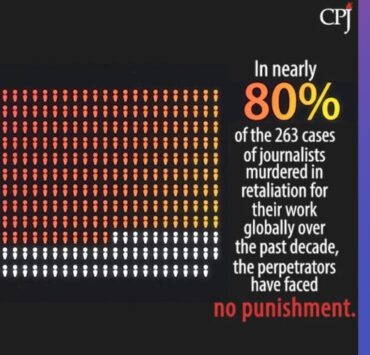
By Revathi Siva Kumar

The third and final day of the 20th anniversary celebrations of the Network of Women in Media, India (NWMI) on 20 March 2022 began with a Mobile Journalism workshop. Facilitated by the Google News Initiative, this workshop had over 50 NWMI members participating from all around thecountry. This turnout on a Sunday morning was a clear indication of how much skills workshops such as these are appreciated by journalists. One participant actually joined from a moving bus in Kashmir.
The workshop was fully bilingual — in Hindi and English. The focus of the workshop was on free tools and apps. And for many participants, the idea that you can edit video with a free app on your phone was marvelous. One participant said that she was keen to acquire these skills to reduce her dependence on external editors and have greater control over her own work and deadlines. So, to be taught video editing live over Zoom by journalism trainers Sanshey Biswas and Manon Verchot was just what the doctor ordered.
Projects and Initiatives
Later in the day, some of our members walked the virtual audience through our latest projects and initiatives in a session called, ‘Network News – What the NWMI has been up to in recent times’. It began with NWMI member Supriya Unni Nair introducing the session, and playing the ’20 Glorious Years’ video for the audience.
Even though hit by COVID-19, NWMI’s projects have been vibrant. Annie Philip, independent journalist and lynchpin of NWMI’s Lest We Forget initiative, observed that even as journalists covered the COVID-19 story, they were also “part of the story, with many journalists falling ill and facing the same difficulties that they were reporting on”. Jolted by desperate tweets for help from Lucknow journalist, Vinay Srivastava, NWMI had taken up the ‘Lest we forget’ initiative in April, 2021. We first accessed the list of names compiled by the Geneva-based NGO Press Emblem Campaign and then added to the list of names, along with photographs and links to obituaries, by crowdsourcing and reaching out to members, media organisations and support workers in diverse regions. We also put out statements and demands to the government and employers. As of publishing, there are 625 names. Though it is not complete, the names are “thankfully not coming in a wave but in a trickle”, Annie added, hoping that it would be closed soon.
Jagriti Chandra from The Hindu spoke about NWMI’s ‘Letdown in Lockdown: Jobs Initiative’. The national lockdown was first announced on March 25, 2020, leading to a spate of nerve-wracking sackings in newsrooms. As celebrity journalists remained silent on social media, NWMI decided to bring up the topic for public discussion. It compiled and tweeted a list of mental health helplines across the country. In April, NWMI members Raksha Kumar and Durga Nandini, noting that journalists were battling serious mental issues and needed help, opened their DMs for interaction and got 10 to 15 queries. For instance, a Kerala journalist who supported her mother, wondered how she would manage if she lost her job, while in Mumbai, a male journalist stressed over supporting his family.
From May 2020, over five months, NWMI hosted six webinars (with guidance from Ammu Joseph, Laxmi Murthy and Geeta Seshu) on coping with job losses, labour rights, freelancing, pitching stories, opening media start-ups and a data journalism workshop. In November, with technical expertise from Supriya Unni Nair, Ayswarya Murthy, Leena Reghunath, Makepeace Sitlhou, Jisha Elizabeth and (her husband) John, NWMI organised its first virtual anniversary.
Anumeha Yadav, journalist and researcher, talked about sexual harassment and violence in workplaces – one of NWMI’s core issues. In the past year, NWMI has issued several public statements condemning rape and death threats to Asianet News Reporter, P R Praveena and the orchestrated hate attacks on Meena Kotwal, Anna Vetticad, Rana Ayyub, Tamil writer Meena Kandasamy and film maker Leena Manimekalai. In 2019, the network had published a survey of 500 women journalists on sexual harassment in a report, Creating Safe Workplaces: Prevention and Redressal of Sexual Harassment in Media Houses in India
The 500-page judgement on the Tarun Tejpal case, being a massive setback for the Indian women’s rights movement and their safety, was analysed by a 12-member NWMI team over a week. We put together a coherent chronology of the eight-year-old case that had dragged on even in a fast-track court. The judgement had not only acquitted rape-accused Tejpal, but even seemed to be attacking the survivor, as “not an ideal victim”, observing that she had not done enough to protect herself and citing details of her personal history, which seemed to be not only inappropriate and unjust but also illegal. It ignored the Supreme Court guidelines and criminal law amendment of 2013, which makes a woman’s consent paramount. The case had come up right after the Verma Committee report a few years before the MeToo movement and the complainant had pointed out that there was no Vishakha Committee in the organisation to probe the case.
NWMI’s analysis showed how the judgement had allowed digital forensic evidence in a manner that undermined her right to privacy, with grave, future implications. The analysis led to some discussion on privacy issues for survivors and how the law, even though it has been progressive, is manipulated in practice.
Anumeha also took note of the acquittal of journalist Priya Ramani in the defamation case by writer and politician MJ Akbar which was hailed as “good news”, with the courts acknowledging that a woman can voice her grievances even decades after being a victim of misconduct. It also observed that a right to reputation cannot be protected at the cost of dignity, with the accused trying to stifle complainants through criminal defamation.
Anjali Mathur, a journalist at CMD (the Information Company), spoke about the NWMI website, which has published 489 articles over its lifetime. More than a 100 of which were put up in the last 12 months preceding this meet! Today, the website is a repository of NWMI’s work, and has published 42 statements against sexual harassment at work, explainers and information on laws, surveys on the media and sharing of women’s experiences. Anjali said that every new initiative, such as the ‘Lest we forget’ list, job initiatives and funding for Afghan journalists, tends to spike the viewership.
The current website is the “fourth avatar”, the first of which was launched a year after the organisation began, back in 2003. It is the network’s window to the world, mapping the members, talking of what they do and opportunities, such as scholarships and jobs. It was revamped four times, mainly to keep up with technology and changing ways of communication. The present website is more responsive, connected more closely to social media channels and more accessible through the mobile phone, so it seems to be easier to update and maintain and more accessible and open to interaction by the younger generation. Anjali ended with a plea for more contributions from the network. Anjali highlighted the logo which has been in place since the first avatar of the website, and the masthead, designed by Manjula Padmanabhan, which has become the network’s identity.
Geeta Seshu, independent journalist, reported on NWMI’s collaboration with Free Speech Collective and Sabrang India to host a discussion titled “India’s deep state: Is any citizen safe?”, on July 26, 2021. She gave a brief backgrounder on how in July, 2021, news about the Pegasus spyware owned by the Israeli-based company, NSO, broke out, related to spying on thousands of prominent dissidents throughout the world. In India, it was used to spy on 300, including 40 journalists, scientists, human rights activists, student leaders, professors, lawyers, opposition party politicians, activists for labour rights and health and citizens like the complainant in the Ranjan Gogoi sexual harassment case.
Jayanti Buruda, first journalist from the Koya Tribe, Odisha, spoke as the first recipient of the NWMI fellowship back in 2017. The fellowship funded entirely by members, for promising journalists working in challenging situations, remote areas or conflict zones. Residents in India from Adivasi communities, Dalit communities, religious or ethnic minority or other disadvantaged groups, or journalists from any Indian language or medium (including print, television, radio, online or photojournalism) are eligible to apply. So far there have been five fellows: Ambika Raja from Kerala (2018), Marouf Gazi from Kashmir (2019), Kavita Katta from Telangana (2020) and Akhila Eashwaran from Tamil Nadu (2021), who sent a video to thank the NWMI network, explaining her project on the lives of fisherfolk in coastal Tamil Nadu.
Next, Sweta Singh, Assistant Professor and Course Coordinator from Guru Gobind Singh, Indraprastha University, explained their report: ‘Gender Perspective in COVID Reportage in India’, a study on the print media in March and September 2020, with a look at the patterns that emerged. Initiated by senior journalist and network member, Sameera Khan, it was sponsored by Population First and UNFP. The study was taken up to examine the coverage given to women during COVID, especially in developing countries. Sweta rued that according to the World Economic Report, 2021, women will have to wait for 135, not 99 years, to close the gender gap. In the study, NWMI mapped the coverage of 12 newspapers in seven languages with the help of various members, such as Parul Sharma, Sumita Jaswal, Prachi Pinglay, Nirupa Rao, Neeta Kolhatkar, Prachi Bari, Uttara Gangopadhyay, Sudarshana Chakraborty, Shruti S, Vidya C K and Chitra Ahanthem, who undertook data collection and monitoring. They tabulated, through both qualitative and quantitative studies, how women and marginalised groups were undercovered. Out of 6,199 stories, only 299 had some significant voices of women and marginalised genders, which was only 4.8% of total coverage. The women’s voices were missing and were not represented as experts or sources, or even when there were major issues that impacted them directly. In many stories, women were not treated on par, or were stigmatised, such as being responsible for infections, or being spreaders of infections.
Sumita Jaiswal, Digital-in-charge of Jagran.com, recalled a webinar related to ‘Gender Inequality in Media’ organised by the NWMI chapter in Bihar that she is part of. The aim of the webinar was to promote gender sensitive and responsive work, leading to transformative journalism. The webinar was responding to patriarchal headlines such as “Chaar bachon ki ma premi ke sangh faraar ho gayi’ (Mother of four elopes with lover). Sumita quoted a damaging line by a senior police officer, a DGP in Bihar: “Ladkiyan apni adaaon se ladkon ko phasaati hai” (girls trap boys with their charm), which were flashed as headlines in reputed newspapers and websites. It’s important to hammer home the gender discourse in media, she said. The Bihar NWMI chapter with UNICEF conceptualised the webinar and also pulled in Hindi, English and Urdu editor to participate and attend. It was a successful webinar, as 150 attendees got connected and remained till the end. It was also meaningful, with editors sharing their experiences to promote gender perspectives, she said.
Padmaja Shaw, retired journalism Professor from Osmania University and independent writer, said that NWMI has been associated with the Global Media Monitoring Project (GMMP), the world’s largest and longest-running gender research organisation, since 2010. The GMMP’s longitudinal data allows for introspection, course correction and for finding a way forward, she said. In India, the team deferred its monitoring programme to September 29, 2020, delayed due to the pandemic and lockdown. Then the teams had to be reconstituted after so many delays, as the earlier volunteers were no longer available. Finally, there were 30 coders, including many NWMI members, in 14 languages across 14 states, who helped code 20 newspapers, five radio channels, eight news websites and Twitter news handles. NMWI members took up a lot of the preparatory work – selection of media, code training, trials and other necessary work. The report was out in November-December. They noticed that during the pandemic, the news priorities shifted in a positive direction. Earlier, it was always politics, government, crime and violence that dictated the news. Post pandemic, the priority was still politics, but the rest of the topics covered had shifted to economy, health and science. Yet, the decline in women’s presence in Indian news media compared to Asia and globally, was depressing, said Shaw.
Yirmiyan Arthur, Photo Editor, Associated Press, spoke about NWMI’s project, Journalists For Afghanistan (JFA), an initiative to extend solidarity and support to Afghan women journalists after the Taliban takeover. NWMI teamed up with the Media Safety and Solidarity Fund (MSSF) in Australia. On August 15, the idea of JFA was seeded, and AP responded promptly, allowing NWMI to use images from its archives for the JFA fundraiser. The works of 24 photographers, four women among them, were used. One of the women scribes, whose photos were used, was Anja Niedringhaus, who was killed while covering the Afghanistan Presidential elections in 2014. The others included Zana Wahidi, the first professional Afghan woman photojournalist. The project owes a big share of its success to photojournalists such as David Guttenfelder, Elizabeth Dalziel, Farzana Wahidy, Mustafa Quraishi and many in the AP team.
The team collected a total of USD100,000. “For some, the work ended then, but for others it began just then,” said Yirmiyan. Laxmi Murthy and Annie Philip of NWMI handled the complex tasks of this initiative, while the disbursal of funds was done by MSSF. Two of the journalists who reached out were pregnant. One of them was in Kabul, while the other was outside the country. A 25-year-old needed a dental operation. Through the initiative, more than 35 women journalists were helped to receive funds ranging from USD500 to USD3,000. Many NWMI journalists are still in touch with those Afghan journalists who have reached Canada and US and have helped them get in touch with other organisations, so that they could be helped to settle and get some work.
As an outcome, NWMI, in collaboration with International Federation of Journalists (IFJ) released a report on Human Rights Day on December 10th, titled ‘In their own words: Afghan women journalists speak’. What really helped was the collaboration with a number of people all over the world, concluded Yirmiyan.
Usha Raman, Professor, Department of Communications at University of Hyderabad, spoke on ‘Staging Aggressive Masculinity’, the report of a media monitoring project, for which she said, she “was pulled out of her academic ivory tower”. Moving away from looking at the familiar method examining content and representation of gender, the team decided to examine how masculinist norms pervade and how journalism and presentations are conducted, examining news panel discussions on prime time and a selected set of social media posts to understand masculinity discourse. The team put together a research framework.
In 2021, with the help of NWMI members, the team monitored 31 news channels, representing news content in 13 languages, including English, over a week in September. NWMI also examined a small number of cases to see if they could identify instances of positive gender norms, but found that only aggressive masculinity pervaded news channels, particularly noticeable in panel shows. The findings were presented in Delhi at an in-person meeting, with a broader spectrum of participants, including activists, practitioners and academics. The team came up with a set of recommendations that they hope will be taken up by media houses and educational institutions, to both sensitise and train journalists for gender positive dialogues during presentations.
Ammu Joseph concluded the session by recalling NWMI’s ‘Gender, Media and Elections’ blog that was launched on April 9, just ahead of the 2014 elections. Its eight-year journey has been active, especially during parliamentary and state assembly elections. The original idea of the blog was to have a space where election coverage could be examined through a gender lens – on how women and other genders are represented and portrayed as voters, candidates, party members, leaders and election officials. It also scrutinised politicians and parties’ record on gender equality, evident in election manifestos and strategies, representation of women among members, workers, leaders and candidates and their approach to the female electorate. Over the years, several members, especially during elections in their home states, or on campaign trails, volunteered to write for the website. Some friends generously provided invaluable guest posts. The blog, in the website’s ‘Gender Lens’ section, aims to contribute to the participation of women in politics, especially electoral politics.
The final day of the anniversary celebrations concluded with a networking session. NWMI chapters introduced their members, and activities. NWMI members also got a chance to discuss future network activities.
View the complete session here:




